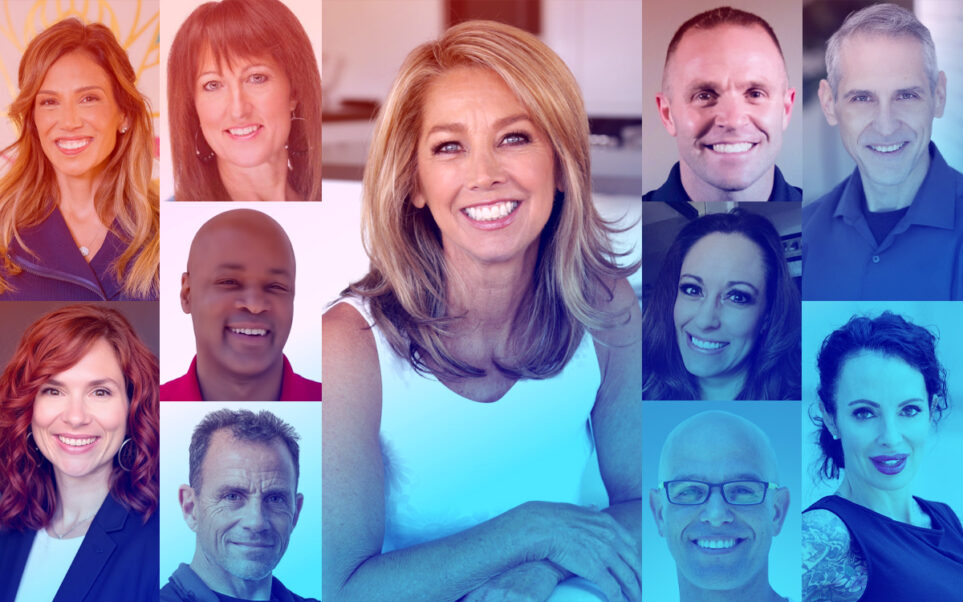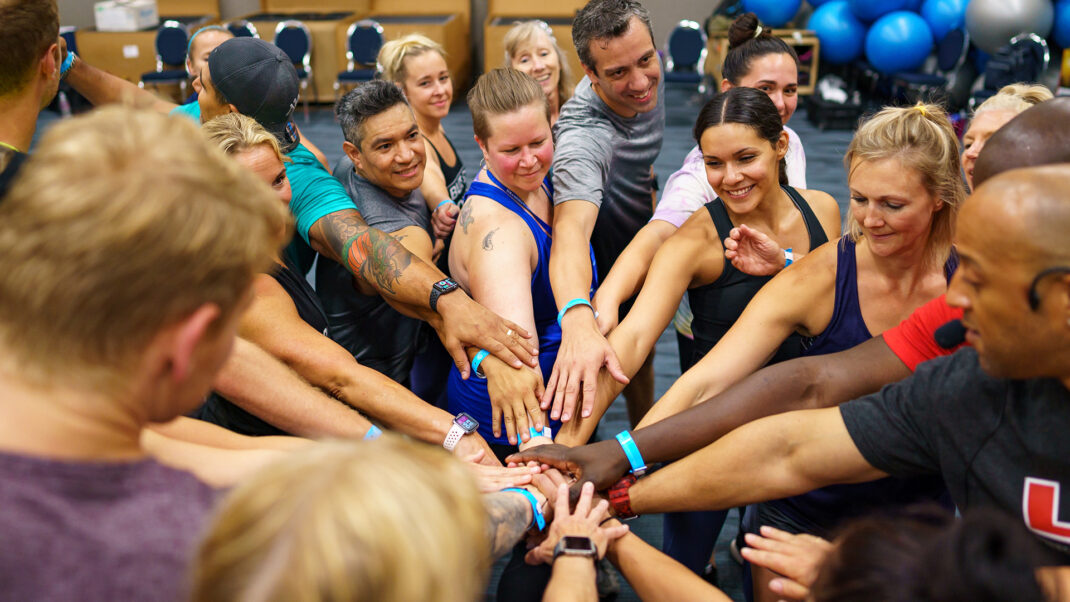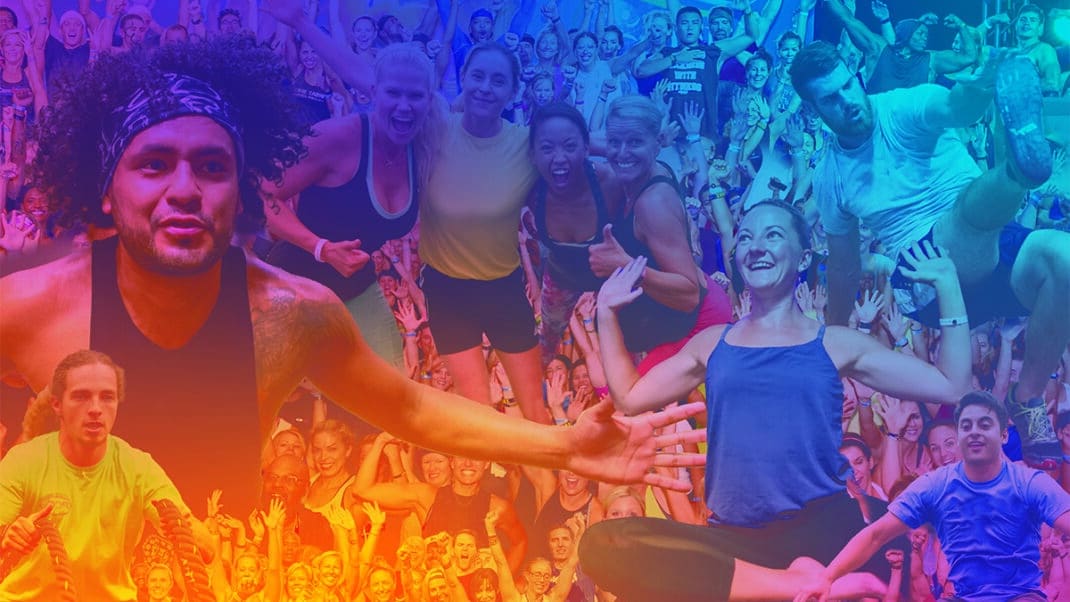Latest on Body Leverage, Biomechanics, Social Media
In true Los Angeles style, IDEA rolled out the red carpet for delegates, guests, educators, exhibitors and VIPs—including U.S. Surgeon General Dr. Regina Benjamin, Los Angeles Mayor Antonio Villaraigosa, entertainer Mario Lopez and tennis star Andre Agassi—at its 2010 IDEA World Fitness Convention August 4–8.
While the tradeshow was a blockbuster, with 150 vendors selling the latest in fitness equipment and technology, the true star of the show was the education, which bore IDEA’s hallmark of research made immediately usable. With more than 350 sessions taught by the most elite corps of fitness educators ever assembled, this year’s program was extremely rich and diverse. Sessions focused on metabolic, body leverage and multiplanar training; fresh, equipment/upgrade-based techniques; business and career topics; and innovations in research, group exercise, nutrition, Pilates, yoga, other mind-body modalities and water fitness.
The World View
Here are some trends that ran throughout the programming:
- We need to put fun into fitness for end users (and for our professional longevity). Our clients work all day, so when they come to us, exercise shouldn’t seem like work; it should surprise, delight and challenge them.
- Getting to the heart of the matter is key. Let’s spend less time telling clients what they already know, and stop allowing them excuses for why they aren’t improving. We need to challenge them–be their guide, but not mollycoddle them. Let’s make clients accountable for their health and fitness–dare them to own it.
- There is no one-size-fits-all approach. “What makes one person’s heart tick may not do it for the next,” said newly minted IDEA Fitness Instructor of the Year Carol Murphy. “Find what makes their heart tick. Get them excited.”
- We’ve reached only a small fraction of the potential fitness market. As Jonathan Ross, 2010 IDEA Personal Trainer of the Year, observed, “We are the special population. We are the weirdoes, because we love exercise.” Millions of untapped customers need assistance.
- Better movement first. Teaching clients to move correctly comes before anything else. Biomechanics need to be the top training priority.
- Life is getting harder for the professional “posers.” Certification organizations are raising the bar, and so are tools like IDEA FitnessConnect, the exciting new free online directory that IDEA launched at the event (see the sidebar below).
- Sports conditioning for kids is hot. Parents understand there is a difference between sport conditioning and regular conditioning, said Peter Twist, MSc, 2010 IDEA Program Director of the Year. “There is a lot of opportunity out there.”
- Exercise is medicine. The fitness industry needs to get more support and buy-in from the medical community.
- Personal training has staying power. “Technology is making people more sedentary,” according to Twist. “Personal training may be the only way people get movement in the future, which will likely make personal trainers more in demand.”
- Family programming is a gateway to tackling childhood obesity and family education about health, nutrition and exercise.
Management and Industry: Synergy in a New Decade
From a gathering of veteran fitness managers and directors, meeting to share successes and pinpoint areas of growth, the dominant theme that emerged was synergy. “What I’m hearing you all talk about is different parts of a whole coming together,” said Amy Thompson, COO of Stroller Strides® LLC in La Jolla, California, and chair of the IDEA program director committee. “There seems to be more synergy between departments, synergy between companies, with corporations and allied health professionals.”
The following highlights reveal some of the buzz at this year’s event.
- Fitness professionals from all generations and parts of the world are leveraging technology like never before. Whether it is through social media, customized applications for smart phones, digital assessments, or internal systems and software for tracking and communication, the industry is streamlining its interactions. Technology bridges the gap, bringing people together in new ways.
- There is a continued push to mentor new fitness professionals, who are trickling in as “hybrids” equipped to train one-on-one and teach groups. There is a dire need for this “new blood” in the group exercise area, and to address this void, managers and directors are creating in-house mentor programs that foster development among new hires. Fitness facilities are also synergizing with universities and colleges that have instructor programs to funnel fresh faces directly into rewarding fitness careers.
- The recession has made the strong stronger, and out of the financial challenges of the past year many fitness professionals have emerged as community leaders. Many facilities and independent contractors used the lull as an opportunity to reach out and offer services at discounted rates. Others volunteered as experts at local 5Ks and wellness events. The result: potential members and clients now know a trusted source for health and wellness advice.
From an attendee perspective, the future looks bright, as education and standards only get better. “I am thrilled and encouraged that the industry continues to focus on the importance of teaching us what a healthy lifestyle looks like, and what it does not look like,” said Erin Hayward, a personal trainer from Mandeville, Louisiana, who was attending her 12th IDEA World Fitness Convention. “At IDEA World Fitness, we have the opportunity to learn from the best of the best about training for fitness and function, not perfection. We learn about balanced nutrition, not the latest fad diet. We are given sound advice backed up by science, and we can confidently pass that information on to our clients.”
Personal Training: Movement Artists Influencing Change
The IDEA World Fitness Convention is always well stocked with the latest exercise tips and techniques for personal trainers.
- There was the usual robust fare of boot camp and sports conditioning sessions that tested participants’ physical and mental limits.
- Presenters such as Brett Klika, director of athletics for Fitness Quest 10 in San Diego, instructed steel-hearted participants on best practices for maximizing the burgeoning group training trend.
- Communication–among fitness pros, or fitness pros and clients–proved a popular topic. “We need a consistent language among all modalities,” challenged Doug Gray of the Gray Institute. “We need a more sensitive nomenclature, which will help to create a more sensitive measurement system.”
- Robert Cappuccio urged attendees to pay attention to what is not being said in a training session. Trainers who pick up on subtleties in facial expressions or body language can gauge clients’ moods and tailor sessions accordingly.
- In his session “Functional Core Training for Life,” Michol Dalcourt argued for functional workouts and questioned the repetitious nature of many fitness regimens. “How many times in a row does a person typically perform a squat [in daily life]? Once.” In place of repetition, Dalcourt called for using different ranges of motion to avoid premature hard- and soft-tissue degeneration.
Group Exercise Convention Highlights
For anyone with a passion for group exercise, the “morning madness” classes—such as “JUKARI Fit to Flex™” and “G.R.A.N.T. Grooves”—were high-intensity fun. And these were just the first of many excellent offerings. Not only were there stupendous sessions like “EMPOWER™ Stepping” with Gin Miller, “Drums Alive® Silver Beats” with Carey Fraley, “Step Success” with Petra Kolber, “Baby Boomer Bounce” with Milo Levell, “Schwinn® Cycling: Ride a Century!” with the irrepressible Bethany Diamond and “Plyometric Cardio Intervals” with Tony Horton, but there were also enticing choices like “Bollywood Step,” “Resist-A-Ball® Hard Core,” “Indo Boarding: Surfing-Inspired Group Fitness,” “Kettlebell Basics for General Fitness” and more, more, more!
And group fitness isn’t just about innovative workouts; it’s about research, too. And nutrition. And teaching methods. And trends. And marketing. The list goes on, as did the session choices. Interesting trends that emerged were an emphasis on strength training for weight loss, particularly for women; a push to make exercise more accessible and fun for true beginners; new ways to use the step; choreography for high-intensity intervals; specialized classes for seniors; the continuing intersection between group fitness and social media/technology; bucket loads of dance-based formats; and the strong crossover between small-group training and group exercise (think TRX®, kettlebells, BOSU® Balance Trainer). Another trend of note was the fluidity between seemingly unrelated disciplines (mixed martial arts, Kranking®, bodywork, freerunning) and group fitness.
Mind-Body-Spirit Goes a Step Beyond
As mind-body-spirit programming has evolved over the past 10-15 years, fitness professionals have discovered that its nuances go beyond targeted breath work, visualization and “connected movement.” All the “traditional” players in this field–yoga, Pilates, tai chi, martial arts–still have a place at the mind-body table. What the industry is realizing is that there are extra chairs for personal training concepts, fusion, coaching, mindful movement and countless other “guests.”
Integration was the theme when it came to this year’s mind-body-spirit programming. More than ever, fitness professionals are seeing that once they are inside the prism of wellness, there are countless refractions of light that offer solutions for clients and participants. There is much more to explore than sets and reps. Here is a glimpse into the many ways that mind-body formats are shaping the industry:
- Today’s fitness professionals are utilizing equipment–both large and small–to complement and expand their repertoires. Examples include mini trampolines, specialized bolsters, custom chairs, small balls and slanted foam wedges.
- Rehabilitation, including prehab and postrehab, is another area of growth. While not every fitness professional is qualified to lead a client through certain stages of rehabilitation, partnering with allied health professionals is standard. Pilates practitioners are becoming more active in the medical community as bridges for their clients. Yoga and gentle movement techniques that incorporate the Feldenkrais Method® and the Alexander Technique are also offering havens for injured clients needing to reconnect with themselves.
- Formats that fully explore the power of the mind are becoming more relevant. Fitness professionals are understanding that the more they learn about the brain and how it functions, the better they can understand and help clients on their journeys.
- Presenters gave example after example of how the deeper layers of knowledge and research affect movement choices across the board. The fitness industry is in the process of incorporating the inner aspects of exercise science and considering how best to explore the “whys” and “hows” for optimal integration.
- As a result of improved education, mind-body-spirit professionals are in a better place to cater to the needs of special populations. Merrithew Health and Fitness, through its premier brand STOTT PILATES®, presented options for a wide range of needs and abilities, including education for men, older adults, athletes and prenatal women. Other Pilates sessions covered knee injuries, osteoporosis and sport-specific conditioning.
- Yoga practitioners and teachers were treated to detailed breakdowns of the sun salutation, as well as in-depth explorations of hands-on teaching and guidance on how to lead a roomful of people of different abilities, ages and backgrounds. In her session “Yoga I.S.®: Better Adjustments,” Lauren Eirk, creator of Yoga Integrated Science™, who is based in Louisville, Kentucky, didn’t parse words as she explained how to adjust a yoga student correctly and professionally. “Even if the same person comes in every day, you must approach that individual as if for the first time, every time,” Eirk said. “You don’t know what’s going on in that person’s life or how her body may have changed from one day to the next.”
- Today’s mind-body-spirit fusion options reflect creativity and careful program design, proving that crossover and cross-training are synonymous with success. Attendees were treated to yoga and cycling; mindful stepping and stability ball training; and movement in the water designed to make you feel “Buddhaful.”
At the IDEA Awards Show in the Nokia Theatre on August 5, IDEA CEO Peter Davis unveiled the much-anticipated IDEA FitnessConnect, the largest national online directory of fitness professionals open to the public–and the only one where profiles are verified by nationally recognized certifying agencies. This powerful platform already has 14 major certification agency verification partners (13 of which are NCCA-accredited) that will verify the certification status of all their listed fitness professionals.
This platform was developed to ensure the success of fitness businesses over the next decade and to help consumers feel confident in searching for qualified fitness professionals in their neighborhood. Without a standard set of guidelines to consider, a consumer search for a personal trainer may yield insufficient or outdated information. “We know consumers understand the importance of exercise, but finding a qualified fitness professional is a huge challenge for them,” said Davis. IDEA FitnessConnect is a business platform for all fitness professionals and health clubs, not just IDEA members. Equipped with powerful marketing tools, fitness pros and managers can spend fewer resources on promotion and more energy inspiring clients. “[Fitness professionals] have told us [that their] biggest challenges are finding ways to make more money, recruit new clients and do so without having to spend all their time marketing or selling,” Davis explained.
If you haven’t filled out your profile yet, go to www.ideafit.com/fitnessconnect. Watch the fun, informative video on the IDEA FitnessConnect home page to get a better idea of the possibilities. This service is absolutely free and will connect you to syndication partners, meaning an estimated 16 million consumers could be looking at your profile by the end of the year. Get connected!













